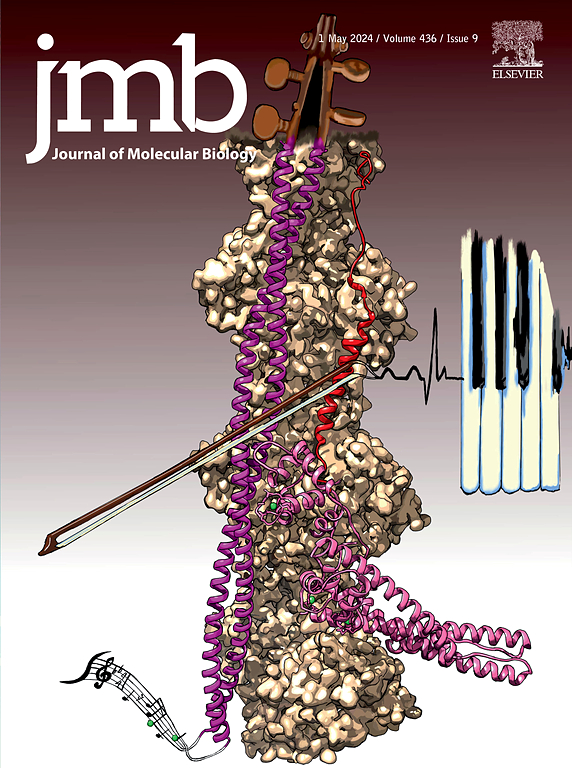Transfer RNA Recognition Mechanism of Thermoplasma acidophilum Trm56, a SPOUT tRNA Methyltransferase that Possesses an Unusually Long C-terminal Region
IF 4.7
2区 生物学
Q1 BIOCHEMISTRY & MOLECULAR BIOLOGY
引用次数: 0
Abstract
Trm56 from Thermoplasma acidophilum is an exceptional SpoU-TrmD superfamily enzyme, which possesses an unusually long C-terminal region, and catalyzes methylation of 2′-OH of ribose of C56 in tRNA. T. acidophilum Trm56 methylates elongator tRNAMet (tRNAMete) transcript effectively, however this enzyme methylates tRNALeu transcript slowly. This enzymatic feature is common in T. acidophilum Trm56 and Pyrococcus horikoshii Trm56, which possesses a short C-terminal region. Kinetic analysis revealed that Km value of T. acidophilum Trm56 for tRNALeu is larger than that for tRNAMete. Our analysis of native tRNAs revealed that the 2′-O-methylcytidine content at position 56 (Cm56) in tRNALeu is 1.9% while in tRNAMete it is 63.1%, showing that the in vitro enzymatic properties of T. acidophilum Trm56 are reflected in the Cm56 modification levels in living cells. Experiments with chimera tRNA transcript of tRNALeu and tRNAMete showed that T. acidophilum Trm56 recognizes the T-loop and the three-dimensional core of tRNA. Furthermore, experiments with mutant tRNAMete transcript revealed that the G53-C61 base pair and U54U55C56purine57purine58 sequence are essential for methylation. Crystal structures of apo- and 5′-methyl-5′-thioadenosine binding forms of the catalytic domain of T. acidophilum Trm56 revealed that the structure of the 5′-methyl-5′-thioadenosine binding pocket and overall structure of the catalytic domain of T. acidophilum Trm56 closely resemble those of P. horikoshii Trm56. Experiments with a chimera of T. acidophilum and P. horikoshii Trm56 proteins demonstrates that the catalytic domain of T. acidophilum Trm56 is responsible for the slow methylation of tRNALeu transcript.

具有异常长c端区的SPOUT tRNA甲基转移酶——嗜酸热原Trm56的转移RNA识别机制
来自嗜酸热原菌的Trm56是一种特殊的SpoU-TrmD超家族酶,它具有异常长的c端区域,并催化tRNA中C56核糖2 ' -OH的甲基化。T. acidophilum Trm56可有效甲基化tRNAMete (tRNAMete)转录物,但其甲基化tRNALeu转录物的速度较慢。这种酶促特征在嗜酸T. acidophilum Trm56和horikoshii焦球菌Trm56中很常见,它们具有短的c端区域。动力学分析表明,tRNALeu对嗜酸T. Trm56的Km值大于tRNAMete。我们对天然tRNAs的分析显示,tRNALeu中56位(Cm56)的2′- o -甲基胞苷含量为1.9%,而tRNAMete中为63.1%,表明嗜酸T. Trm56的体外酶促特性反映在活细胞中Cm56的修饰水平上。tRNALeu和tRNAMete嵌合体tRNA转录本实验表明,T. acidophilum Trm56能够识别T-loop和tRNA的三维核心。此外,tRNAMete突变体转录本的实验表明,G53-C61碱基对和U54U55C56purine57purine58序列是甲基化所必需的。对T. acidophilum Trm56催化结构域的载子-和5′-甲基-5′-硫代腺苷结合形式的晶体结构分析表明,T. acidophilum Trm56的5′-甲基-5′-硫代腺苷结合袋的结构和催化结构域的整体结构与P. horikoshii Trm56非常相似。对嗜酸乳杆菌和平氏p.p horikoshii Trm56蛋白嵌合体的实验表明,嗜酸乳杆菌Trm56的催化结构域负责tRNALeu转录物的缓慢甲基化。
本文章由计算机程序翻译,如有差异,请以英文原文为准。
求助全文
约1分钟内获得全文
求助全文
来源期刊

Journal of Molecular Biology
生物-生化与分子生物学
CiteScore
11.30
自引率
1.80%
发文量
412
审稿时长
28 days
期刊介绍:
Journal of Molecular Biology (JMB) provides high quality, comprehensive and broad coverage in all areas of molecular biology. The journal publishes original scientific research papers that provide mechanistic and functional insights and report a significant advance to the field. The journal encourages the submission of multidisciplinary studies that use complementary experimental and computational approaches to address challenging biological questions.
Research areas include but are not limited to: Biomolecular interactions, signaling networks, systems biology; Cell cycle, cell growth, cell differentiation; Cell death, autophagy; Cell signaling and regulation; Chemical biology; Computational biology, in combination with experimental studies; DNA replication, repair, and recombination; Development, regenerative biology, mechanistic and functional studies of stem cells; Epigenetics, chromatin structure and function; Gene expression; Membrane processes, cell surface proteins and cell-cell interactions; Methodological advances, both experimental and theoretical, including databases; Microbiology, virology, and interactions with the host or environment; Microbiota mechanistic and functional studies; Nuclear organization; Post-translational modifications, proteomics; Processing and function of biologically important macromolecules and complexes; Molecular basis of disease; RNA processing, structure and functions of non-coding RNAs, transcription; Sorting, spatiotemporal organization, trafficking; Structural biology; Synthetic biology; Translation, protein folding, chaperones, protein degradation and quality control.
 求助内容:
求助内容: 应助结果提醒方式:
应助结果提醒方式:


